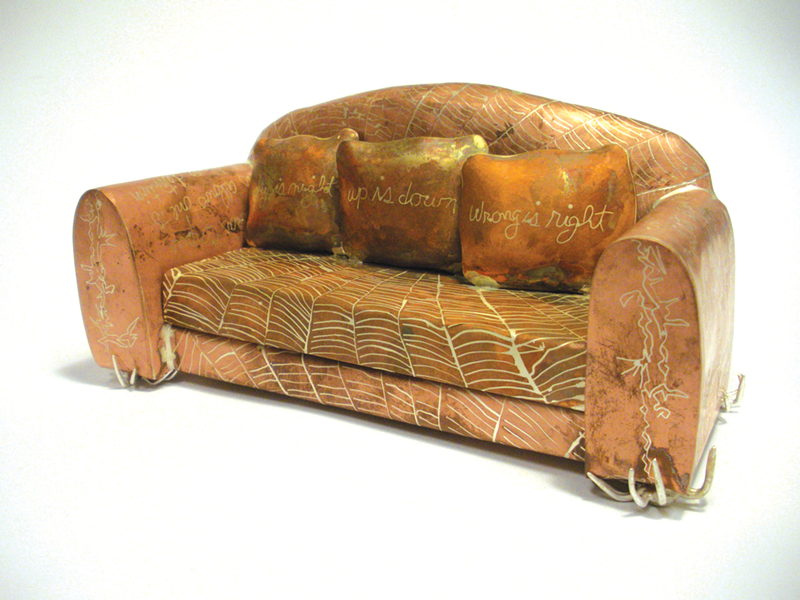NINE is just fine — both the name and the Carnegie exhibit.
The title discloses only the number of artists, who represent ceramics, sculpture, painting, glass and mixed media. The show is without an obvious or assigned theme. But rather than feeling like a mish-mash, it works. “Each gallery tells a different story from a unique point of view, creating a singular experience that will have something for everyone,” reads the media release. Without a framework in place, connecting with a piece is an even more personal experience.
Gallery director Bill Seitz says he’s collected Terri Kern’s ceramics for years and saw big things for her. He means that literally, too; he had a dream in which Kern created life-size sculptures. She’s not doing that, but the new Cincinnati Arts Ambassador is making changes. Kern, known for brightly painted pottery, here displays a darker palette of rusty browns and the greens and grays of an old penny. Her familiar symbols (birds = Kern and women, snakes = forgiveness, ladders = doubt, books = past regrets and unknown futures) have been freed from plates and vases and are now fully realized as three-dimensional objects.
In “Lesson,” a ladder curves down to a bird resting at an open tome. There are three closed books between the rungs. Mistakes have been resolved, apparently, for the bird’s tail is a snake. But in other works, doubt is still holding a bird back. Wings are snared between ladders in “Caught,” and in “Momentum” a bird still must shake a ladder off its tail feathers. There should be no doubt about Kern’s talent, though.
While Kern’s ceramics zero in on the female experience, Scott Dooley’s whimsical teapots speak to guys who might prefer garages to galleries, and to the kid in each of us.
Dooley’s pots and pitchers are made of porcelain but look like mufflers, oilcans and funnels that have been welded and riveted together, then left outside to become dinged and rusted. The vessels bend at crazy, hard angles and appear near collapse. The Wittenberg University instructor creates them for fun rather than function. “They’re like Dr. Seuss!” a friend observed on opening night.
Kimberly Anderson of Indiana and Carrie Longley of suburban Dayton are ceramic artists who share an interest in life cycles and interrelationships. But they get different grades for originality and appeal.
Anderson’s pitchers and other porcelain objects combine the feminine form with petals and prickly pods that suggest the reproductive system. While pretty, the hybridization of females and flora is “as old as any human idea,” as the exhibit program points out. Less expected are Longley’s sculptures marrying science and art. Placed under glass domes, the bone-colored objects resemble human organs, tumors and spiny mutant animals. “That one looks like a bug from Men in Black,” my friend decided. Longley’s collection both attracts and repels, especially after noting that her materials include pig intestines.
Jessica Metzler also uses unconventional materials, but she’s all about beauty. Sporting rainbow hair, bright lips and thick lashes, the Louisville high school senior and Carnegie scholarship winner has made self-portraits incorporating hair dye, lipstick and eyeliner. Seitz praises her as “unafraid to pick up anything and make art of it.”
Robert Robbins (Columbus College of Art & Design) and Robert F. Schroeder (Indiana University-Purdue University) offer contemplative pieces big and small, respectively. Robbins’ paintings of dense woods are busy yet calming. As the scenes envelop you, they prompt an outpouring of memories and questions about what’s ahead.
Schroeder heads indoors, creating little worn chairs and overstuffed couches of copper, brass and bronze that are inlaid with silver line drawings and text. Each is a container serving as a memorial to or study of a person (Simon Wiesenthal), place (a favorite bungalow) or idea (habeas corpus). A collage of sketches and articles accompanies each object. Together they suggest a comfortable library for conversation.
The final artists are Ellen Hiltz and former CityBeat contributor Alan Pocaro. Hiltz’s fused glassworks are the most commercial pieces in the exhibit, and I could not get a sense of the Newport woman’s point of view. (I did like her suspended squiggles that look like black licorice strings.) Pocaro’s colorful, frenetic paintings and collages successfully convey a world in flux. But overall the New Aesthetics artist’s work seems to be more about the process than the result, presenting an obstacle to full appreciation.
While NINE is not a 10, you will find more than one artist whose work speaks to you.
NINE is on view through Dec. 21 at the Carnegie Visual and Performing Arts Center, 1028 Scott Blvd., Covington. thecarnegie.com.






